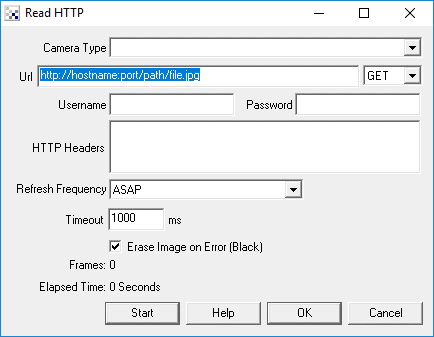HTTP Read
The HTTP Read module allows you to process images from remote site across the internet instead of from your connected webcam. This module can also be used to access internet enabled webcams that may be connected on your local network.
Interface

Instructions
1. Camera Type - select which type of camera you wish to connect to.
2. Url - Enter the web URL in the provided box. The url should be a HTTP Push server or to a single web image that when reloaded would provide a different image. Any url provided via the Camera Type dropdown will need to be configured for your domain. If your camera type does not appear in the Camera Type list you will need to find the appropriate url to use that when access will deliver a MJPEG image over a http protocol.
3. Enter the HTTP Method in the dropdown
4. Username/Password - Enter any Basic HTTP authentication in the username and password text boxes.
5. Headers - Enter any additional HTTP headers needed
6. Refresh Frequency - Select how frequently the image should be reloaded. In the case of HTTP Push the image will always be updated as quickly as the remote server provides the image.
7. Erase on Error - if the remote camera fails to send images (during a network/power/etc failure) clear the image to black to indicate an error.
8. Timeout - the number of milliseconds to wait for a remote image. When this fails the image will be cleared based on the above "Erase on Error" and a system variable SYSTEM_ERROR will be set to indicate this timeout failure. Note that the rest of the pipeline DOES execute even after this error.
Example
1. Insert the HTTP_READ module (located under the Loading/Saving level) into the RoboRealm processing pipeline.
2. Enter the url specific to your camera. For the Axis 206 you would enter in your url looking something like
http://camera.ip.address/mjpg/video.mjpgbut note that your IP number will most likely be different. If you do not know the url of your camera image you may need to look under the hood of a HTML page that shows the streaming image. You most likely have that page installed with the software that comes with the camera. Using your browser select 'view source' and look for the url.
3. Press the "start" button and if you don't get any errors then you should then see the image start streaming.
The HTTP_READ module does NOT read HTML pages. You need to provide it with the specific url that will return a jpeg image. If will understand both moving jpeg images (mjpg) OR still jpeg images that refresh each time they are reloaded.
Note that DLink, TRENDnet and Linksys cameras have their own modules specific to those cameras to allow for more of the camera features to be accessed in RoboRealm.
VLC Media Player
If you want to stream from a VLC server, you need to start the capture using VLC and then select the Stream option under the Media menu. You will need to Add Http as a Destination, edit a profile to select MJPEG encapsulation and M-JPEG as the Video codec in order for VLC to stream using MJPEG. Once you press the Steam button at the end of the Wizard, you can now use this module with http://localhost:8080/ as the URL assuming you didn't change the defaults. This should then start showing the image within the main RoboRealm window.
Your final streaming output string should be something like
:sout=#transcode{vcodec=MJPG,vb=800,scale=Auto,width=320,
height=240,acodec=none}:http{mux=mpjpeg,dst=:8080/} :sout-keep
Note that while streaming VLC may not show the image being streamed.
See Also
RTSP Player
VLC Player
HTTP Text Module
| New Post |
| HTTP_Read Related Forum Posts | Last post | Posts | Views |
| None |
